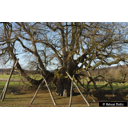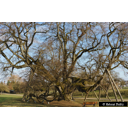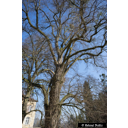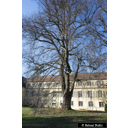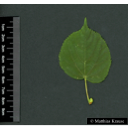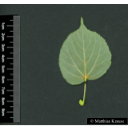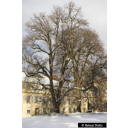Useful information about the taxon (species, subspecies, variety...)
Tilia cordata Mill. 1768
Malvaceae
(APG IV)small-leaved lime, small-leaved linden
Akzessionnummer: EG-F-058-19615
Pflanzjahr: 2016
Patenschaftstext: Baum des Jahres 2016. Gepflanzt von der Universität Hohenheim und der Schutzgemeinschaft Deutscher Wald e.V.
Taxon concept: The Plant List (2010)
Distribution: Europe, Caucasus, North Iran, western Siberia, western Asia
Size: 10 - 30 (m)
Tilia cordata Mill. - Accepted: Tilia cordata Mill. bei Zander 2008; Familie: Tiliaceae (Zander 2008)Tilia cordata Mill. - Accepted: Tilia cordata Mill. bei The Plant List (2010); Familie: Malvaceae (APG III)Tilia parvifolia Ehrh. ex Hoffm. - Synonym: Tilia cordata Mill. bei The Plant List (2014), version 1.1; Familie: Malvaceae (APG III)Tilia cordata Mill. - Accepted: Tilia cordata Mill. bei The Plant List (2014), version 1.1; Familie: Malvaceae (APG III)Tilia cordata Mill. - Accepted: Tilia cordata Mill. bei The Plant List (2014), version 1.1; Familie: Malvaceae (APG IV)Tilia cordata Mill. - Accepted: Tilia cordata Mill. bei Schmeil-Fitschen 2019; Familie: Malvaceae (APG IV)Tilia cordata Mill. - Accepted: Tilia cordata Mill. bei BfN Checklist Flora DE; Familie: Malvaceae (APG IV)Tilia cordata Mill. - Accepted: Tilia cordata Mill. bei World Flora Online - APG IV (Angiosperms); Familie: Malvaceae (World Flora Online - APG IV (Angiosperms))
- Color of flower
- whitish green
- Flowers
- hermaphrodite flowers
- Flower ecology
- insect-pollinated (honeybees)
- Life form
- woody, tree
- Leaves
- upper leaf side glabrous
- Foliage persistence
- deciduous
- Fruit ecology
- wind-dispersed (anemochorous)
- Soil conditions
- preferentially on fresh to moderately dry, alkaline, neutral to slightly acidic, humus-rich, mostly deep, sandy or stony loam, loess or clay soils
- Light conditions
- semi-shade to shade plant (Oberdorfer 2001)
- Root type
- top soil and deep rooting plant
- Succession type
- soil stabiliser
- Natural occurrence (habitat)
- thermophilous mixed deciduous forests, oak-hornbeam forests, oak-ash forests, mixed ravine and slope forests, maple slope forests, montane forests; at summer warm climate sites
- Vegetation typ and synecology (plant community)
- temperate, mixed mesophytic deciduous forests; Carpinion character species, also member of Tilio-Acerion, Quercion roboris or Alno-Ulmion
- Constraints according soil conditions
- sensitive to salt
- Constraints according moisture
- not drought resistant
- General recommendation
- recommended for beekeeping
- Usage
- as ornamental tree; wood can be used for making small furniture and tool handles; used as medicinal plant: has sedative, antispasmodic, diaphoretic and diuretic properties
- Phytopathogenic organisms
- is sensitive to the fungal pathogen Phytophthora plurivora
- Altidudinal lower limit (sea level in m)
- 0
- Altitudinal higher limit (sea level in m)
- 1,600
Bundesamt für Naturschutz (BfN) (1999-2001 and ongoing): Floraweb - Daten und Informationen zu Wildpflanzen und zur Vegetation Deutschlands. www.floraweb.de.; Erhardt, W., Götz, E., Bödeker, N. & Seybold, S. (2008): Der große Zander. Enzyklopädie der Pflanzennamen. Band 2. Arten und Sorten. Eugen Ulmer KG, Stuttgart (Hohenheim), 18. Aufl., 2103 S.; European Forest Genetic Resources Programme (2009): EUFORGEN. See: http://www.euforgen.org; Haider, M. et al. (2005): Wildbienenkataster. See: https://www.wildbienen-kataster.de; Hishinuma, S. M. et al. (2015): Wingnut (Juglandaceae) as a new generic host for Pityophthorus juglandis (Coleoptera: Curculionidae) and the thousand cankers disease pathogen, Geosmithia morbida (Ascomycota: Hypocreales). Canadian Entomologist, 148(1): 83-91.. DOI: https://doi.org/10.4039/tce.2015.37; Kämper, Wiebke et al. (2018): Flower visitation honeybee and bumblebee. See: https://www.bexis.uni-jena.de/ddm/data/Showdata/16086?version=2; Maurizio, Anna et al. (1982): Nektar und Pollen - die wichtigsten Nahrungsquellen der Honigbiene. 4. Ehrenwirth, München, 3, überabeitete Auflage; Oberdorfer, E. (2001): Pflanzensoziologische Exkursionsflora. Für Deutschland und angrenzende Gebiete. Eugen Ulmer Verlag, Stuttgart, 8., stark überarb. u. erg. Aufl, 1056 S. 978-3-8001-3131-0.; Pritsch, Günter et al. (1985): Bienenweide.. Neumann-Neudamm, Melsungen; Pritsch, Günter et al. (2007): 200 Trachtpflanzen erkennen und bewerten.. Kosmos, Stuttgart; Schick, B. & Spürgin, A. (1997): Die Bienenweide. Eugen Ulmer Verlag, Stuttgart, Auflage: 4., völlig neubearb. u. erw. A., 216 S. 978-3800174188.; The International Plant Names Index (2009). Published on the Internet http://www.ipni.org; Courtesy to IPNI, 2009. Exported from IPNI at date: 2009-09-22 20:17:51; Werle, Susanne et al. (2015): ITS2 DNA metabarcoding of wild bee pollen loads, collected in 2020 and 2021 across all three exploratories. See: https://www.bexis.uni-jena.de/ddm/data/Showdata/31545?version=6; Westrich, P. et al. (2018): Die Wildbienen Deutschlands.. Ulmer Verlag ISBN 978-8186-0123-2.;
Diese Webseite verwendet Google Maps, um Karten und Standorte von Pflanzen in den Hohenheimer Gärten anzuzeigen. Dadurch werden unter Umständen Daten an Google weitergeleitet, was mit einer Verarbeitung Ihrer personenbezogenen Daten verbunden sein kann. Die Datenschutzerklärung von Google finden Sie hier: Datenschutzerklärung von Google

